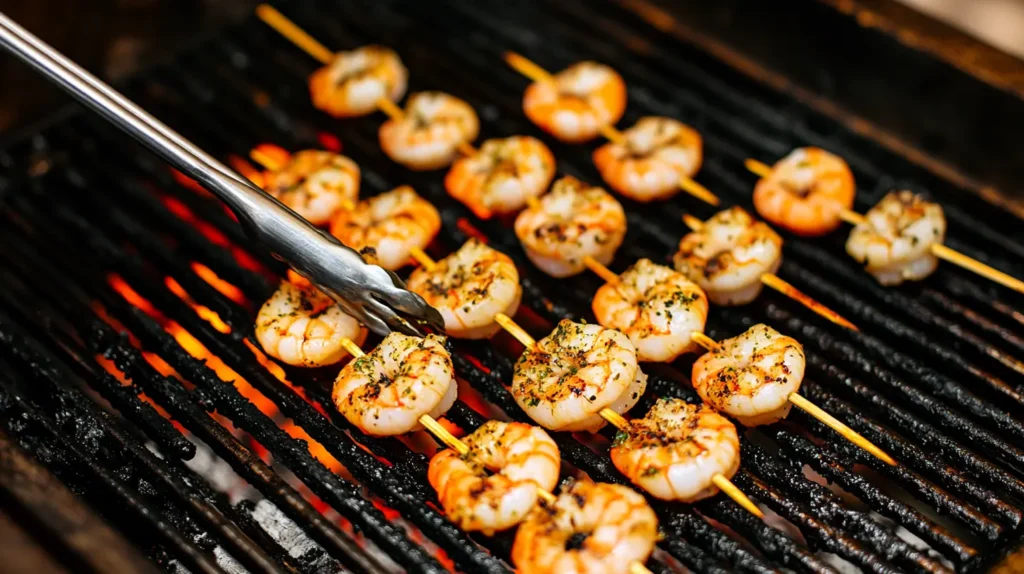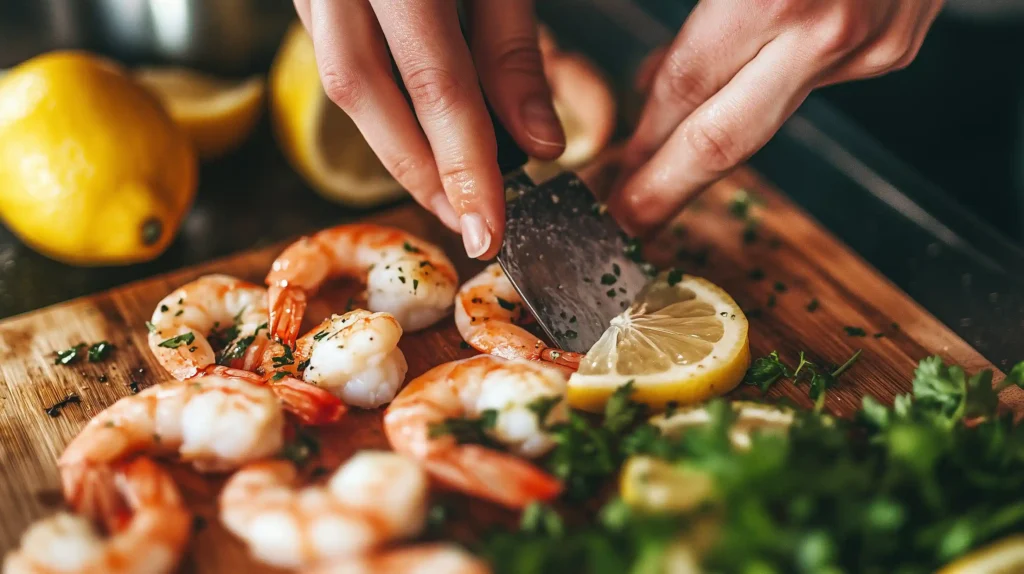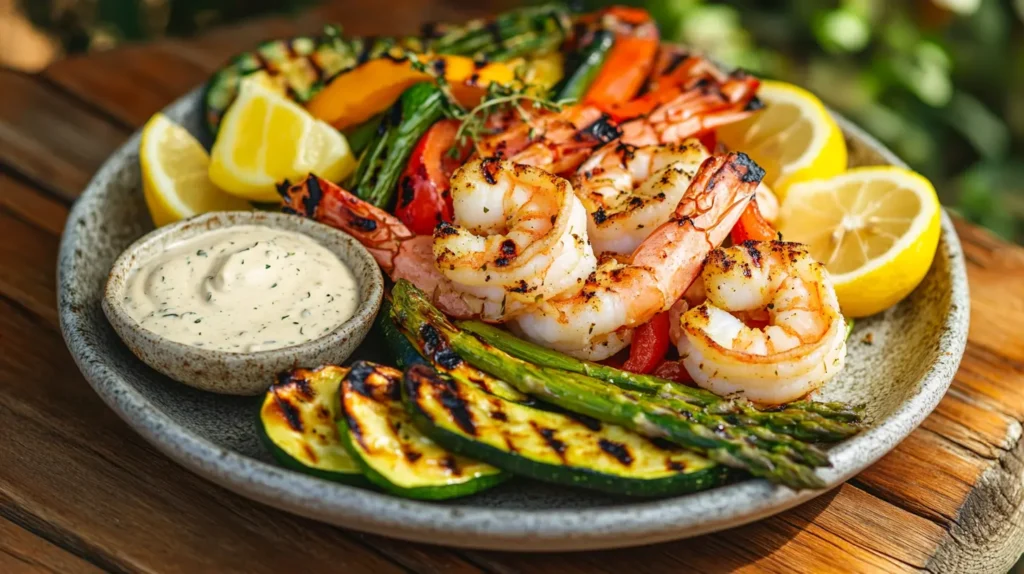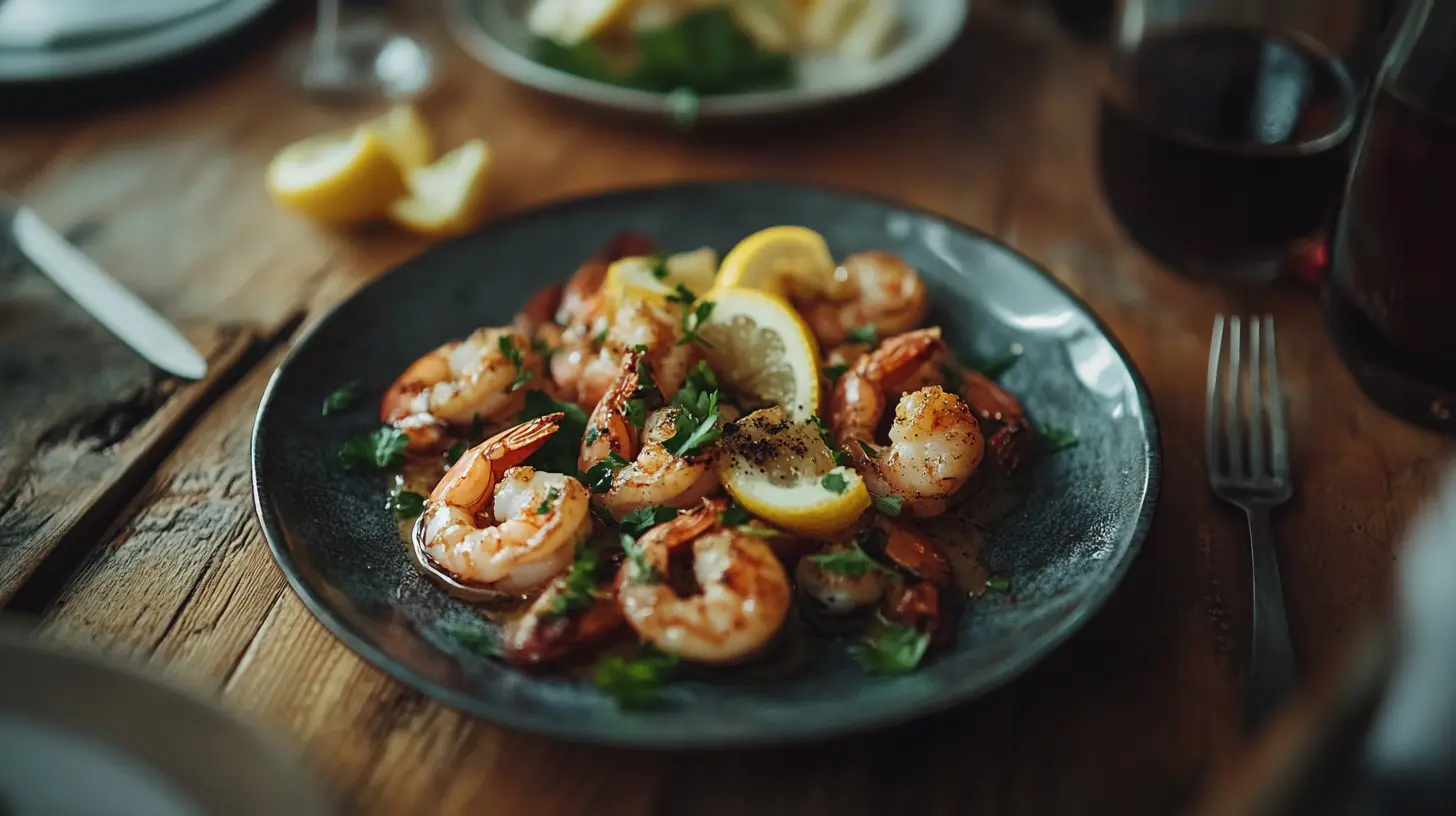Grilling shrimp is one of the easiest and quickest ways to enjoy seafood, but timing is everything! Overcook them, and they turn rubbery. Undercook them, and you risk food safety issues. So, how long do shrimp take on the barbecue? The answer depends on several factors, including the shrimp’s size, cooking method, and grill temperature.
This guide will take you through everything you need to know about grilling shrimp to perfection. We’ll explore cooking times, best grilling techniques, preparation tips, and common mistakes to avoid. By the end, you’ll be ready to fire up the barbecue and serve up delicious, juicy shrimp every time.
Now, let’s dive into the details!
Table of Contents
Introduction to Grilling Shrimp
Shrimp is a go-to choice for grilling enthusiasts because it’s fast, flavorful, and versatile. Unlike beef or chicken, which can take much longer to cook, shrimp can be ready in mere minutes. However, nailing the right grilling technique is key to achieving tender, juicy shrimp instead of dry, overcooked bites.
Why Grilled Shrimp is a Popular Choice
What makes shrimp a barbecue favorite? Here are a few reasons:
- Quick Cooking Time – Unlike other proteins, shrimp takes only a few minutes to grill.
- Mild Yet Flavorful – Shrimp absorbs marinades, spices, and seasonings beautifully.
- Pairs Well with Many Dishes – Whether served on skewers, with rice, or in tacos, shrimp complements a variety of flavors.
- Healthy and Nutritious – Packed with lean protein and omega-3 fatty acids, grilled shrimp is a nutritious meal choice.
The Importance of Cooking Time for Perfect Shrimp
The biggest mistake when grilling shrimp? Overcooking! Shrimp can go from plump and juicy to tough and chewy in a matter of seconds. The secret lies in understanding:
- How long shrimp should cook on the barbecue
- How to recognize when shrimp is perfectly done
Cooking time varies depending on shrimp size, grill temperature, and whether the shrimp is fresh or frozen.
Factors Affecting Shrimp Cooking Time on the Grill
A few factors influence how long shrimp takes to cook on the barbecue:
- Size Matters – Jumbo shrimp take longer than smaller ones.
- Grill Temperature – Higher heat speeds up cooking, but too much can char the shrimp.
- Shell-On vs. Peeled – Shrimp with shells take slightly longer but retain more moisture.
- Skewers vs. Direct Grilling – Shrimp on skewers tend to cook more evenly than loose shrimp on the grill.
Now that we’ve covered the basics, let’s move on to how long shrimp actually takes to cook on the barbecue! 🚀
How Long Do Shrimp Take on the Barbecue?
Shrimp is one of the quickest proteins to cook, but how long do shrimp take on the barbecue exactly? The answer depends on multiple factors, including shrimp size, grill temperature, and cooking method.
General Cooking Time for Shrimp on a BBQ
On a medium-high grill (375-400°F), shrimp typically takes:
- 2 to 3 minutes per side for medium to large shrimp
- 3 to 5 minutes per side for jumbo shrimp
The key is to grill shrimp just until they turn pink and opaque, avoiding overcooking, which can make them tough and rubbery.
Size and Type of Shrimp: How They Affect Cooking Time
Shrimp size plays a significant role in cooking time:
- Small shrimp (51-60 count per pound) – 1-2 minutes per side
- Medium shrimp (41-50 count per pound) – 2-3 minutes per side
- Large shrimp (31-40 count per pound) – 3-4 minutes per side
- Jumbo shrimp (21-30 count per pound) – 4-5 minutes per side
Additionally, shell-on shrimp may take slightly longer since the shell acts as a barrier to heat. However, it helps retain moisture and enhances flavor.
How to Tell When Shrimp Are Fully Cooked
Shrimp are perfectly cooked when they:
✅ Turn from gray/blue to pinkish-orange
✅ Become opaque with a slightly firm texture
✅ Form a gentle “C” shape (a tight “O” shape means overcooked)
For extra precision, use a meat thermometer. Shrimp is fully cooked at an internal temperature of 145°F.
Now that you know the exact cooking times, let’s look at the best grilling methods for shrimp! 🔥
Best Grilling Methods for Shrimp
Now that you know how long shrimp take on the barbecue, let’s explore the best grilling methods to get perfect results every time.

Direct Heat vs. Indirect Heat Cooking
Grilling shrimp over direct heat is the most common method because it cooks them quickly while adding a nice char. However, for extra-large shrimp or delicate marinades, using indirect heat can help prevent burning while still achieving a smoky flavor.
- Direct Heat: Place shrimp directly over the flames for quick cooking (2-4 minutes per side).
- Indirect Heat: Move shrimp to the cooler side of the grill for slower, even cooking (4-6 minutes per side).
Using Skewers vs. Cooking Shrimp Directly on the Grill
- Skewers: Prevent shrimp from falling through the grates and make flipping easier. Metal skewers work well, but if using wooden skewers, soak them for at least 30 minutes before grilling.
- Grill Basket: A great option for grilling multiple shrimp at once without worrying about flipping each one.
- Direct on the Grate: Works best for larger shrimp that are easier to flip with tongs.
Grilling Shrimp with or Without the Shell
- Shell-On Shrimp: Adds a protective layer that prevents overcooking and enhances flavor.
- Peeled Shrimp: Allows for better seasoning absorption but requires more attention to prevent drying out.
💡 Pro Tip: Brushing shrimp with olive oil or butter before grilling prevents them from sticking and enhances flavor!
Preparing Shrimp for the Grill
Before throwing shrimp on the barbecue, proper preparation is essential for flavorful, evenly cooked results. From cleaning to seasoning, these steps will help you get the most out of your grilled shrimp.
Cleaning and Deveining Shrimp Before Cooking
If you’re using fresh shrimp, start by:
- Peeling (optional): Some prefer grilling shrimp with the shell on for extra flavor. If peeling, remove the shell while leaving the tail intact for easy handling.
- Deveining: Use a small knife to make a shallow cut along the back and remove the black vein. While not harmful, it can add a gritty texture.
- Rinsing: Quickly rinse shrimp under cold water and pat dry to remove excess moisture.
Marinating and Seasoning Options for the Best Flavor
Shrimp absorb flavors quickly, so a short marinade (15-30 minutes) is ideal. Here are some tasty seasoning options:
- Classic Garlic Butter: Melted butter, garlic, lemon juice, and parsley.
- Spicy Cajun: Olive oil, smoked paprika, cayenne, and black pepper.
- Citrus Herb: Lime zest, olive oil, and fresh herbs like cilantro or thyme.
- Asian-Inspired: Soy sauce, sesame oil, ginger, and honey for a sweet-savory twist.
Avoid acidic marinades (like vinegar or citrus) for longer than 30 minutes, as they can break down the shrimp’s texture.
Choosing the Right Oil for Grilling Shrimp
To prevent shrimp from sticking to the grill, coat them lightly in high-smoke-point oils, such as:
- Avocado oil
- Grapeseed oil
- Canola oil
Brushing oil on shrimp before grilling ensures a perfect char without burning.
Now that your shrimp is prepped, let’s move on to the step-by-step grilling process! 🔥
Step-by-Step Guide to Grilling Shrimp
Preheating the Grill to the Right Temperature
Knowing how long shrimp take on the barbecue is one thing—grilling them correctly is another. Follow these steps to get perfectly grilled shrimp every time.

A hot grill is key to even cooking and searing. Preheat your barbecue to 375-400°F (medium-high heat) for at least 10 minutes.
- Gas grill: Set burners to medium-high.
- Charcoal grill: Let the coals turn white before cooking.
- Pellet grill: Choose a medium-high setting.
Proper Placement of Shrimp on the Grill for Even Cooking
Once the grill is hot, place shrimp directly over the flames if using skewers or a grill basket. If grilling individually, space them evenly to prevent overcrowding.
Shrimp should cook for:
✅ 2-3 minutes per side for medium shrimp
✅ 3-4 minutes per side for jumbo shrimp
Pro Tip: Flip shrimp only once! Overhandling can cause them to dry out.
Flipping and Monitoring Cooking Time for Juicy Shrimp
Flip shrimp once they turn pink on one side and develop light grill marks. Shrimp are done when:
- They’re opaque and slightly firm
- The tails curl into a C-shape
- Their internal temperature reaches 145°F
Remove shrimp from the grill immediately and serve hot and fresh!
With this step-by-step method, you’ll never have to worry about overcooked, rubbery shrimp again. Now, let’s explore common mistakes and how to avoid them! 🚀
Common Mistakes When Grilling Shrimp
Grilling shrimp is easy, but small mistakes can lead to overcooked, dry, or flavorless results. Avoid these common pitfalls to make sure your shrimp turns out perfectly juicy and flavorful every time.
Overcooking Shrimp: How to Avoid Tough and Chewy Texture
One of the biggest mistakes when grilling shrimp is leaving them on the heat for too long. Shrimp cook fast—typically 2-3 minutes per side on a hot grill.
Signs of overcooked shrimp:
❌ Shrimp curl tightly into an “O” shape
❌ The texture becomes rubbery and tough
❌ They lose their natural juiciness
✅ How to prevent overcooking:
- Stick to the recommended cooking time based on shrimp size.
- Remove shrimp from the grill as soon as they turn pink and opaque.
- Use a meat thermometer—145°F is the perfect internal temperature.
Undercooking Risks and Food Safety Considerations
While overcooking ruins the texture, undercooked shrimp can pose food safety risks. Shrimp should never look gray or translucent once removed from the grill.
✅ How to ensure shrimp is fully cooked:
- Look for a uniform pink color with no gray spots.
- Check that the shrimp forms a gentle “C” shape instead of a straight body.
- If in doubt, use a thermometer to confirm the 145°F internal temperature.
Mistakes in Seasoning and Marinades That Can Ruin the Flavor
Seasoning and marinating shrimp improves taste, but improper techniques can backfire.
🚫 Common seasoning mistakes:
- Skipping oil – Without a light oil coating, shrimp can stick to the grill.
- Over-marinating – Acidic marinades (like lemon or vinegar) can break down shrimp texture if left too long.
✅ Fix it by:
- Marinating shrimp for no longer than 30 minutes.
- Using a balance of oil, spices, and mild acids.
By avoiding these mistakes, you’ll grill shrimp like a pro every time! Now, let’s look at side dishes and serving ideas to complement your grilled shrimp.
Best Side Dishes and Serving Ideas for Grilled Shrimp
Now that you know how long shrimp take on the barbecue and how to grill them perfectly, let’s talk about what to serve with them. Shrimp pairs well with a variety of fresh, vibrant sides that enhance its flavor.

Pairing Shrimp with Vegetables on the Grill
Grilling shrimp? Why not throw some veggies on the barbecue, too? These grilled side dishes make for a complete meal:
- Grilled Asparagus: A drizzle of olive oil, salt, and a squeeze of lemon make this a perfect side.
- Charred Corn on the Cob: The natural sweetness of corn complements smoky shrimp flavors.
- Zucchini and Bell Peppers: Lightly seasoned and grilled until tender, these veggies add color and texture.
Rice, Pasta, and Salad Combinations
If you prefer a heartier meal, serve grilled shrimp with:
- Garlic Butter Rice – A simple yet flavorful side that soaks up juices beautifully.
- Lemon Herb Pasta – Light and fresh, with olive oil, parmesan, and fresh basil.
- Mango Avocado Salad – The sweetness of mango with creamy avocado creates a refreshing contrast to smoky shrimp.
Dipping Sauces That Enhance Grilled Shrimp Flavor
Sometimes, all grilled shrimp needs is a delicious dip:
- Garlic Butter Sauce – Classic, rich, and buttery.
- Spicy Sriracha Mayo – A creamy, spicy kick for shrimp lovers.
- Chimichurri Sauce – A fresh and herby sauce that adds a burst of flavor.
With the right sides and sauces, you can take your grilled shrimp meal to the next level! Up next, let’s answer some common shrimp grilling questions.
FAQs – Answering Common Questions About Grilling Shrimp
Many people have questions about grilling shrimp, from preventing them from sticking to ensuring they cook evenly. Below, we answer some of the most common grilling concerns.
How do you keep shrimp from sticking to the grill?
Shrimp can stick to the grates if they’re not properly prepared. To prevent this:
- Oil the shrimp lightly before grilling. Using a high-smoke-point oil like avocado or canola oil works best.
- Preheat the grill for at least 10 minutes to ensure even heat distribution.
- Use a grill basket or skewers to prevent shrimp from falling through the grates.
Should you peel shrimp before grilling?
It depends on personal preference.
- Peeled shrimp absorb seasonings better and are easier to eat.
- Shell-on shrimp retain more moisture and have a slightly richer flavor.
- Best option? Try grilling with the shell on and peeling afterward for a juicy result!
Can you grill shrimp from frozen, or should they be thawed first?
Shrimp should always be thawed before grilling for even cooking. If grilled from frozen, the outside can burn while the inside remains undercooked. For quick thawing:
- Place shrimp in cold water for 10-15 minutes.
- Drain and pat dry before seasoning and grilling.
What is the best temperature for grilling shrimp?
Shrimp grill best at medium-high heat (375-400°F). Cooking them at this temperature ensures:
- A quick sear without overcooking.
- A slight char for extra smoky flavor.
- Juicy, tender shrimp that don’t turn rubbery.
Now that your shrimp grilling questions are answered, let’s wrap up with some final thoughts and grilling tips!
Final Thoughts and Expert Grilling Tips
Grilling shrimp is quick, easy, and incredibly delicious, but timing is everything! Now that you know how long shrimp take on the barbecue, you can grill them to perfection every time.
Key Takeaways for Grilling the Perfect Shrimp
Here’s a quick recap of the most important grilling tips:
✅ Shrimp cook fast! Most shrimp are done in 2-4 minutes per side at medium-high heat.
✅ Avoid overcooking. Perfectly grilled shrimp turn pink and opaque but stay plump.
✅ Oil is your best friend. Lightly oil shrimp before grilling to prevent sticking.
✅ Use skewers or grill baskets. These make flipping easier and prevent shrimp from falling through the grates.
✅ Marinate wisely. Keep acidic marinades under 30 minutes to avoid a mushy texture.
Experiment with Flavors and Techniques
Once you’ve mastered the basics, try different seasonings, marinades, and cooking methods:
- Smoky and bold? Use a chipotle-lime rub.
- Sweet and spicy? Brush with honey sriracha sauce.
- Herby and fresh? Grill with lemon, garlic, and parsley.
With the right techniques and flavors, your grilled shrimp will impress every time! Now, fire up the barbecue and enjoy the perfectly grilled shrimp experience. 🔥🍤
If you’re exploring more ways to enjoy seafood, consider trying these recipes:
- Grilled branzino with crispy skin, perfect for elevating your barbecue menu.
- Rockfish tacos with slaw, a creative and flavorful dish for taco night.

